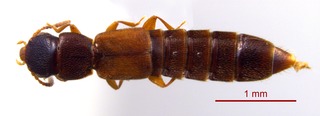
The Omaliinae are a subfamily of the Staphylinidae, rove beetles.

Pselaphinae are a subfamily of beetles in the family Staphylinidae, the rove beetles. The group was originally regarded as a separate family named Pselaphidae. Newton and Thayer (1995) placed them in the Omaliine group of the family Staphylinidae based on shared morphological characters.

The Paederinae are a subfamily of the Staphylinidae, rove beetles. The Paederinae include two tribes, Paederini and Pinophilini. This insect may refer to Tomcat.

The Osoriinae are a subfamily of beetles in the family Staphylinidae, the rove beetles. They are found mainly in tropical and subtropical regions.

The Dasycerinae are a subfamily of the Staphylinidae (Coleoptera) rove beetles.

Steninae is a subfamily of Staphylinidae.

The Aleocharinae are one of the largest subfamilies of rove beetles, containing over 12,000 species. Previously subject to large-scale debate whether the subfamily deserved the familial status, it is now considered one of the largest subfamilies of rove beetles.
The Empelinae are a subfamily of rove beetles ; their biology is virtually unknown. Their anatomy and ecology resemble many rove beetles.

The Euaesthetinae are a subfamily of the Staphylinidae (Coleoptera). These rove beetles have slender antennae with two or three apical antennomeres forming a loose club. The tarsi have 4-4-4 or 5-5-5 segments. They are found in forest litter. Five genera and 22 species known from North America.

The Habrocerinae are a subfamily of the Staphylinidae, rove beetles.

The Leptotyphlinae are a subfamily of the Staphylinidae, rove beetles. They are very small, less than 1.8 mm long, and are eyeless and wingless. These beetles appear to have seven abdominal segments, and 3-3-3 is their tarsal formula. They are found in leaf litter or deep soil, possibly as predators of mites, collembola, and other soil arthropods. Nine genera and 13 species are known from North America, in western states and Florida, but they may be more widespread.

The Megalopsidiinae are a subfamily of the Staphylinidae, rove beetles. They have large eyes, antennae with distinct di- or trisegmented clubs. The tarsal formula is 5-5-5. They have unique elongated processes at theanterior margin of the labrum. They are found in decaying trees and fungus-infested logs. In North America, one genus and two species: Megalopinus caelatus (Gravenhorst) and M. rufipes (LeConte) are known.

The Micropeplinae are a subfamily of the Staphylinidae, rove beetles. Their antennae have 9 segments with single-segmented clubs. The tarsal formula is 4-4-4. They are found in leaf litter, near lake shores and marshy areas, in mammal and bird nests, probably as saprophages or mold feeders. In North America, two genera are known Kalissus LeConte 1874 and Micropeplus Latreille, with 14 widespread species.
The Olisthaerinae are a subfamily of the Staphylinidae. They are similar to the Phloeocharinae. Their habitat is under the bark of dead conifers. Their biology is poorly known. The tarsal formula is 5-5-5. In North America, two species, Olisthaerus megacephalus (Zetterstedt) and O. substriatus (Gyllenhal) are known,from Alaska across Canada to New York.

The Oxyporinae are a subfamily of the Staphylinidae discovered in 1839 by Erichson. One genus, Oxyporus Fabricius, with six species, is found in North America.

The Oxytelinae are a subfamily of the Staphylinidae, rove beetles. They have a unique pair of defensive glands opening onto the ninth tergum. Most have seven complete sterna visible. The tarsal patterns are 2-2-2, 3-3-3, 4-4-4, or 5-5-5. They are generally found in moist places: moss along streams, leaf litter, beaches, etc.

Phloeocharinae Erichson 1839 are a subfamily of Staphylinidae.

Proteininae Erichson 1839 are a subfamily of Staphylinidae.

Pseudopsinae is a beetle subfamily of Staphylinidae.

Scaphidiinae is a subfamily of Staphylinidae.























